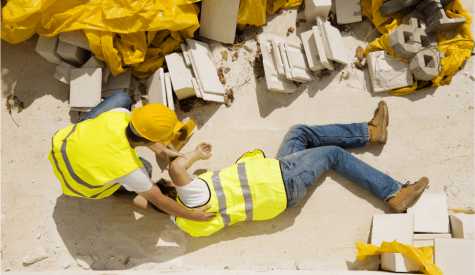Don’t Forget About Industrial Ergonomic Safety Training

Employees are usually familiar with the more obvious hazards in the industrial facility they work in. Maybe they’re working near an open flame, there are chemicals involved in processing, or they work on an elevated surface. All these job tasks have clear hazards associated with them.
However, employees typically aren’t as familiar with the ergonomic hazards they face in their job. Just like any other hazard, employers are required to protect employees from ergonomic hazards. With potentially costly OSHA citations and the risk of injuring employees, it is critical that all companies take steps to identify and address ergonomic hazards within their workplace.
Ergonomics and The Risks
Ergonomics is the study of designing and arranging things so people can interact with those things safely and efficiently. Simply put, ergonomics is fitting the job to the worker, not the worker to the job.
Poor ergonomics can lead to musculoskeletal disorders (MSDs), which are soft-tissue injuries caused by sudden or sustained exposure to repetitive motion, force, and awkward positions. MSDs can affect muscles, nerves, tendons, joints, and cartilage in the upper and lower limbs, neck, and lower back.
With symptoms including pain and physical limitations, employees can see effects both at work and at home. In addition, treatment can be expensive and extensive, and both employers and employees can potentially face significant bills. Instead of putting employees at risk, training them in good ergonomic practices can reduce the risks of developing an MSD.
Some of the most common musculoskeletal disorders associated with ergonomic hazards include:
- Tendonitis
- Carpal tunnel syndrome
- Degenerative arthritis
- Herniated discs
While some MSDs are cured with rest and time off, others are permanent and will affect the employee forever.
Common Workplace Hazards
Below are the most common types of ergonomic hazards encountered in the workplace.
- Repetitive motion disorders are caused by too many uninterrupted repetitions of an activity or motion. These are most common in the hands, wrists, elbows, but can occur in nearly any part of the body. Some examples of repetitive motions in the workplace include:
- Assembling products on a line
- Packing items in boxes
- Testing products
- Cutting and slicing food products
- Lifting items onto shelves or an assembly line
- Awkward postures occur when the body deviates significantly from a neutral position while performing work activities. This can include both sitting and standing positions and is often found in work with a lot of prolonged reaching, twisting, or working overhead. Some examples include:
- Hunching over your work or desk
- Reaching over or around objects to reach your tasks
- Sitting or standing in the same position for hours at a time
- Excessive force or forceful exertion comes from handling of too-heavy loads and/or loads with no handles, and poor maintenance of both equipment and the facility. This overuses and overstretches the muscles without enough rest. Some examples include:
- Using carts on rough flooring
- Using tools with loose handles
- Lifting awkward and/or heavy items alone
- Lifting, sometimes known as manual material handling, has to do with workers moving objects by manually lifting, lowering, filling, emptying, or carrying them. Other workplace examples include:
- Lifting items onto an assembly line
- Carrying finished items to shelves or trucks
- Loading trucks
What You Can Do
There are many different methods for correcting ergonomic hazards, and they will primarily depend on the facility. For most MSDs, ensuring workers are taking regular breaks helps immensely as it allows them to pause, stretch their muscles, and reset physically and mentally.
Lifting is one hazard that is often unavoidable and perhaps needs the most awareness. One method of easing the stress on employees is by using material-handling aids, which can include:
- Hand trucks
- Pallet jacks
- Carts
- Ratchet hoists
- Forklifts
- Cranes
Physical aids can be used both to reduce the lifting and carrying in a task, but also to reduce the amount of bending an employee needs to do. For example, using a forklift to bring a load to the same height as the shelf it is going on can reduce the need to bend over and lift.
If you are not using material-handling aids, it is crucial that all employees follow safe lifting practices. The steps for safe lifting are:

- Test the load: Ask for help if the load is too heavy, big, or is an awkward shape.
- Wear proper clothing: Wear appropriate shoes and gloves, and long sleeves if necessary.
- Secure your grip: Start with a secure grip, then lift smoothly, avoiding jerking motions.
- Keep it close: Keep the load close to your body and use your legs to lift.
- Turn with your feet: Avoid twisting your body, instead rotating with your feet.
- Take breaks: Be sure to take frequent breaks to not overexert yourself.
In addition to using material-handling aids and practicing safe lifting, employers should ensure that employees are practicing good housekeeping, and using safe scheduling to reduce the risk of injuries. Safe scheduling gives employees the opportunity to rotate the type of task that they’re doing.
Employers should also add anti-fatigue floor mats to standing workstations, purchase ergonomic chairs for sitting stations, and encourage employees to alternate sitting and standing as much as possible.
There are many options for both employers and employees to prevent poor ergonomics. Simply making a few small changes to the facility can lead to reduced injuries, less time off needed for MSDs, and improved employee morale.
Employee training in ergonomic safety should always be part of your safety program. See how HSI can help you tailor your employee training to target the specific hazards found in your workplace.


